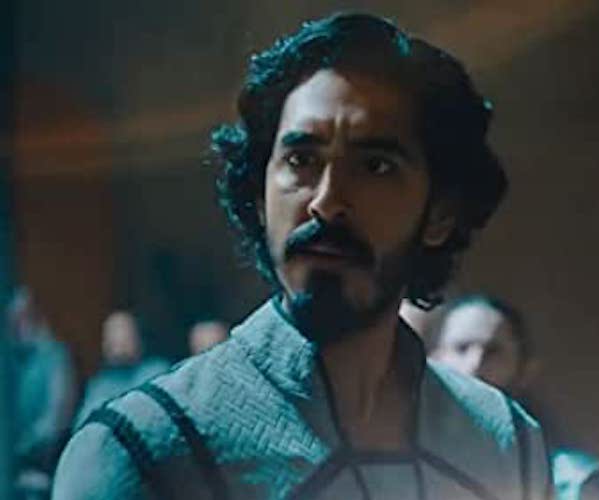Film Review: “The Green Knight” — An Art-House Medieval Drama
By Gerald Peary
Is what we see real or in the spirit world? Whatever, I cheer on filmmaker David Lowery’s luminous time-traveling. Pure cinema poetry.
The Green Knight, directed by David Lowery. Screening at Coolidge Corner Cinema, Kendall Square Cinema, and other movie houses throughout New England.

Dev Patel stars as Gawain — nephew to King Arthur and an aspiring knight — in The Green Knight, filmmaker David Lowery’s adaptation of the 14th-century anonymous poem, Sir Gawain and the Green Knight.
Pity the college frosh weaned on action movies who checks out The Green Knight expecting a summer movie roller coaster ride into the Middle Ages. True, David Lowery’s film has come out in escapist August, but it’s as determinedly anti-action as you can get, an intentionally slow-paced, serious-minded adaptation of the 14th-century verse romance, the anonymous Sir Gawain and the Green Knight. When swords come out, very occasionally, it’s for a valid dramatic reason, not for a programmed moment of crowd-pleasing violence. Lowery, as writer-director-editor, has dared craft an art-house medieval drama, and an excellent one, whose impressive Arthurian antecedents (I wonder if Lowry, 40, has seen them) would be such long ago French classics as Robert Bresson’s Lancelot du Lac (1974) and Eric Rohmer’s Perceval (1978).
Most critics have embraced The Green Knight. Yet a reviewer friend of mine saw this one as a dull mess of underlit, foggy scenes. He also complained he just couldn’t understand the story. Well, I loved the murky, Wellesian atmosphere. As for the narrative: Lowry certainly doesn’t spoon-feed you. King Arthur and Guinevere are prominent in the tale, but I don’t believe their iconic names are ever announced, nor are the anonymous knights identified who gather around a crude rock Round Table. Is Lancelot in the house? Nor is the magic word “Camelot” ever spoken. If you need a grasp on what Lowery adapted ahead of a viewing, do as I did. I boned up on the plot of Sir Gawain on the Green Knight via a fine entry on Wikipedia.
Having never read the original, I’m not sure if Lowery quotes lines directly from the olden text in his literary-bent screenplay. It’s a tribute to the filmmaker’s writing skills that Middle English (or faux Middle English) blends in so effectively with lines of a more contemporary lilt.
The movie starts with Sir Gawain (a modest, nonheroic Dev Patel) discovered drinking and partying with his lowly friends and commoner girlfriend, Essel, in the bowels of a castle. For a nobleman, Gawain is a washout, concerned with fun not honor, even though he’s the nephew of King Arthur. But all of this changes in an instant. Reminiscent of libertine Prince Hal being summoned to court in Shakespeare’s Henry IV, 1, Gawain is ordered to appear at the Round Table. He is placed by the side of his mighty uncle. It’s an uncomfortable meeting, as the King and Queen confess they hardly know him. Arthur asks Gawain to tell a story of his life. Gawain admits he has none.
How can this lightweight sit next to the King in a room filled with the mighty Knights of the Round Table? We are not privy to Gawain’s motive, but it can be surmised that the time has come — he wants to show himself as worthy. When a mysterious Green Knight on horseback interrupts the meeting, the impulsive Gawain is the only one in the house who answers the intruder’s challenge. A “game.” The Green Knight, who looks like Neptune morphed onto a tree trunk, says something like this: “Cut off my head with a sword and, in one year, come to where I live and I’ll cut your head off.” What’s wrong with this picture, in which the Green Knight would be safely dead, incapable of revenge? Gawain quickly finds out. Chopped off, the Knight’s severed head refuses to lie on the ground. It climbs back onto the Knight’s neck, and the Knight, resuscitated, trots off on his stallion.

Dev Patel as Gawain in a scene from The Green Knight.
Love versus duty, the ancient chivalric theme. The old Gawain would have ignored what was now required of him and remained home with his girlfriend. She adores him, wants him close. The new Gawain wavers for a while, but finally is resolute. He climbs on a horse and rides away, pledged to fulfill his fatal part of the bargain. Now, it’s The Quest to Find the Green Knight, and, as with all such quests from The Odyssey to Lord of the Rings, fraught with perilous adventures. Gawain is the most human, vulnerable of protagonists. He almost cries of fright when captured and roped by a group of marauders. He can’t resist a buxom vixen (the intoxicating Alicia Vikander) who looms over his bedside. What are the chances that he’ll act nobly when the Green Knight demands his head?
In one of his adventures, Gawain comes upon a pale apparition of a noblewoman who — a constant motif in this movie — is seeking her lost head. He’s told it lies in a pool of water. Might he fetch it? “Are you real or a spirit?” Gawain queries her. “Who cares?” is her answer. And that would be Lowery’s response as well. Going back to his masterly A Ghost Story (2017), the filmmaker navigates an on-screen netherworld where the real and unreal float mesmerically together. So too with The Green Knight, which proffers an eerie, hallucinatory atmosphere where almost all the people (Gawain excepted) feel like airy, slippery phantoms.
And one more key connection to The Ghost Story. In his previous film, Lowery managed a remarkable free-flowing montage in which the goings on in one house are projected over days, years, centuries into the future. I have never seen a movie that dramatized the shifting sands of time so brilliantly, lucidly, and philosophically. The filmmaker as seer. Lowery leaps again into the future in The Green Knight. There’s a stirringly edited, immensely ambitious scene in which he envisions what could happen if Gawain returned home and, on Arthur’s death, became King himself: we see him transformed into a greedy, bloodthirsty warrior whose maltreatment of his women sets the stage for Henry VIII. Is this the Gawain who, not even a knight, we’ve come to root for? Is what we see real or in the spirit world? Whatever, I cheer on Lowery’s luminous time-traveling. Pure cinema poetry.
Gerald Peary is a Professor Emeritus at Suffolk University, Boston, ex-curator of the Boston University Cinematheque, and the general editor of the “Conversations with Filmmakers” series from the University Press of Mississippi. A critic for the late Boston Phoenix, he is the author of nine books on cinema, writer-director of the documentaries For the Love of Movies: the Story of American Film Criticism and Archie’s Betty, and a featured actor in the 2013 independent narrative Computer Chess. His latest feature documentary, The Rabbi Goes West, co-directed by Amy Geller, has played at film festivals around the world.


If you loved this movie and it gets you interested in the original author, I hope you’ll read the short poem “Pearl.” It’s a dream vision of a grieving father who lost a young child. It’s the first poem in English literature that can break your heart.
I have to agree with your reviewer friend. This from someone who loves your movie essays and thoughts on film. Maybe the film critics were so happy not to have a slam bam action film that they lost their perspective.